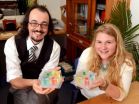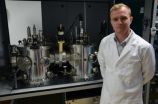(Press-News.org) AMES, Iowa – Ludovico Cademartiri had what seemed like an impossibly demanding list of requirements for his lab equipment.
The Iowa State University assistant professor of materials science and engineering wants to understand environmental effects on plant growth, specifically how variations in climate and soil characteristics affect root growth. That requires highly controlled environments that expose whole plants to environmental effects such as nutrients, water, oxygen gradients as well as physical obstacles for the roots.
Greenhouses can create fairly controlled environments for whole plants, but they're homogeneous. And microfluidic technologies can create highly controlled micron-scale environments, but they're expensive, relatively complex and not easy to scale up.
Cademartiri was looking for a way to study plant and root growth that was simple, inexpensive and flexible, something that allowed experiments to be reproduced all over the world, even in labs without the latest technologies or the infrastructure required for plant science or agronomy research.
He was looking for something modular, scalable and structurally precise. He wanted something simple, reproducible, affordable and capable of many simultaneous experiments. He was looking for something transparent, autoclavable, three-dimensional, chemically inert and compatible with existing plant growth experiments.
And he thought of the perfect something from the toy aisle: LEGO bricks.
"Forget for a minute that they're used as toys," Cademartiri said. "They're actually pieces of high-quality plastic, built to extraordinary standards of precision, that you can use to build stuff."
They're also "a good example of how something simple can solve a complex design problem," he said.
Cademartiri and his research group report their use of LEGO bricks to successfully build engineered environments for plant and root studies in a paper just published by the peer-reviewed, online journal PLOS ONE.
The paper's authors include Cademartiri; Kara Lind, an Iowa State doctoral student in materials science and engineering; Saida Benomar, a former postdoctoral research associate at Iowa State and the U.S. Department of Energy's Ames Laboratory; Anthony Miller, a former Iowa State undergraduate in agronomy; and Tom Sizmur, formerly a postdoctoral research associate at Iowa State and the Ames Lab, now of Rothamsted Research in Harpenden, England.
Lind said her primary role with the project was figuring out how to configure transparent LEGO bricks to hold gel or other soil substitutes for germinating and growing plants. She also experimented with ways to make the LEGO environments bigger to accommodate growing plants. And she developed techniques to create controlled chemical gradients in the LEGO environments with the intent of testing plant response to nutrients and toxins.
"When I started this research program, there was a lack of tools for the creation of highly controlled and yet frugal environments capable of holding an entire plant," Cademartiri said. "The first objective we focused on was building a library of tools that would be accessible to everybody and allow them – and us – to proceed to scientific experiments."
The researchers accomplished their objective: "We here demonstrate that LEGO bricks are highly convenient and versatile building blocks for building centimeter-scale engineered environments for plant roots," they wrote in their paper.
Will the paper have other researchers visiting the toy aisle or placing orders at lego.com?
"We do believe it could be useful," Cademartiri said.
The researchers wrote in their paper that they'll continue to develop this library of tools for "the fabrication of frugal but sophisticated" environments for studies of plants and other organisms.
INFORMATION: END
Iowa State engineers turn LEGO bricks into a scientific tool to study plant growth
2014-06-26
ELSE PRESS RELEASES FROM THIS DATE:
Veterans who identify as LGB could benefit from informed mental health services
2014-06-26
COLUMBIA, Mo. – In 2011, the United States Military repealed its "don't ask, don't tell" policy that prevented gay and lesbian service members from disclosing their sexual orientation. Current estimates indicate that more than 1 million veterans identify as lesbian, gay or bisexual (LGB). Now, a University of Missouri researcher says these service members and veterans often are marginalized and may benefit from mental health professionals, including social workers, who are informed about the needs of individuals who identify as LGB.
"Identifying as LGB and serving in ...
Penn study shows changing roles of physicians with MBAs
2014-06-26
Philadelphia - According to a new study from researchers at the Perelman School of Medicine and the Wharton School at the University of Pennsylvania, physician graduates from the MBA program in heath care management at Penn's Wharton School report that their dual training had a positive effect on their individual careers and professional lives. Study respondents reported such benefits as career acceleration, professional flexibility, and credibility in multidisciplinary domains. Aside from clinical practice, the MD was more often cited as providing professional credibility, ...
Controlling movement with light
2014-06-26
For the first time, MIT neuroscientists have shown they can control muscle movement by applying optogenetics — a technique that allows scientists to control neurons' electrical impulses with light — to the spinal cords of animals that are awake and alert.
Led by MIT Institute Professor Emilio Bizzi, the researchers studied mice in which a light-sensitive protein that promotes neural activity was inserted into a subset of spinal neurons. When the researchers shone blue light on the animals' spinal cords, their hind legs were completely but reversibly immobilized. The ...
Why tech transfer brings universities 'more than money'
2014-06-26
Tampa, Fla. (June 26, 2014) – Academic technology transfer – the process of moving research from the lab to the market – provides intrinsic benefits to universities that go far beyond any potential revenues from licenses and royalties.
So say the authors, from five universities across the country and the Association of University Technology Managers (AUTM), in a new article from the National Academy of Inventors (NAI) that appears in the current issue of Technology and Innovation and is available Open Access.
"More than Money: The Exponential Impact of Academic Technology ...
Chimps like listening to music with a different beat, research finds
2014-06-26
WASHINGTON – While preferring silence to music from the West, chimpanzees apparently like to listen to the different rhythms of music from Africa and India, according to new research published by the American Psychological Association.
"Our objective was not to find a preference for different cultures' music. We used cultural music from Africa, India and Japan to pinpoint specific acoustic properties," said study coauthor Frans de Waal, PhD, of Emory University. "Past research has focused only on Western music and has not addressed the very different acoustic features ...
Traffic light labels can give a false sense of security
2014-06-26
This news release is available in German. Sugar: red; fat: yellow; salt: green. The so-called 'food traffic lights' used in Great Britain indicate the volume of certain nutrients contained in a product by means of color-coded information on the packaging. The intention is to enable consumers to identify the advantages and disadvantages associated with a food product at a glance. The traffic light labeling system is a controversial topic throughout Europe. Since the financial crisis, it is also discussed for investment products.
Scientists from the Technische Universität ...
Tofu ingredient could revolutionize solar panel manufacture
2014-06-26
The chemical used to make tofu and bath salts could also replace a highly toxic and expensive substance used to make solar cells, a University study published in the journal Nature has revealed.
Cadmium chloride is currently a key ingredient in solar cell technology used in millions of solar panels around the world. This soluble compound is highly toxic and expensive to produce, requiring elaborate safety measures to protect workers during manufacture and then specialist disposal when panels are no longer needed.
Now, a University of Liverpool researcher has found ...
Deeper insights into protein folding
2014-06-26
Investigating the structure and dynamics of so-called Meso-Bio-Nano (MBN) systems—micron-sized biological or nanotechnology entities—is a rapidly expanding field of science. Now, scientists Alexander Yakubovich and Andrey Solov'yov from MBN Research Centre in Frankfurt, Germany, have produced a new theoretical study of a protein macromolecule changing from a coil structural conformation to a globular one. Their statistic mechanics model, just published in EPJ D, describes the thermodynamic properties of real proteins in an aqueous environment, using a minimal number of ...
New NASA images highlight US air quality improvement
2014-06-26
Anyone living in a major U.S. city for the past decade may have noticed a change in the air. The change is apparent in new NASA satellite images unveiled this week that demonstrate the reduction of air pollution across the country.
After ten years in orbit, the Ozone Monitoring Instrument (OMI) on NASA's Aura satellite has been in orbit sufficiently long to show that people in major U.S. cities are breathing less nitrogen dioxide – a yellow-brown gas that can cause respiratory problems.
Nitrogen dioxide is one of the six common pollutants regulated by the U.S. Environmental ...
Blocking key enzyme minimizes stroke injury, UT Southwestern research finds
2014-06-26
DALLAS – June 26, 2014 – A drug that blocks the action of the enzyme Cdk5 could substantially reduce brain damage if administered shortly after a stroke, UT Southwestern Medical Center research suggests.
The findings, reported in the June 11 issue of the Journal of Neuroscience, determined in rodent models that aberrant Cdk5 activity causes nerve cell death during stroke.
"If you inhibit Cdk5, then the vast majority of brain tissue stays alive without oxygen for up to one hour," said Dr. James Bibb, Associate Professor of Neurology and Neurotherapeutics at UT Southwestern ...




